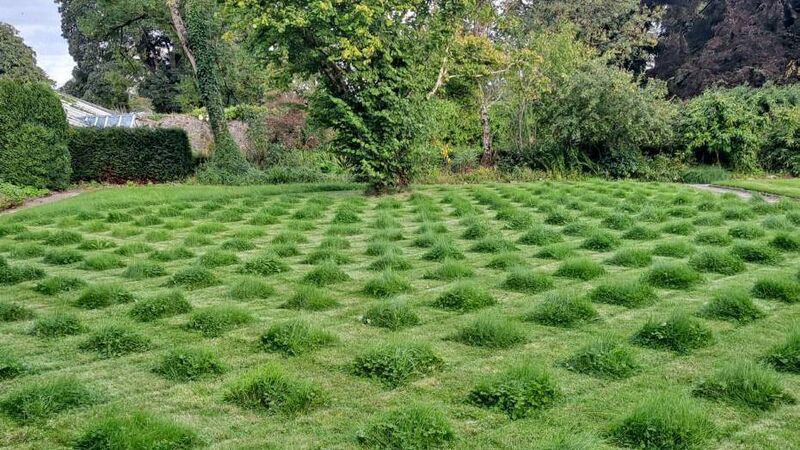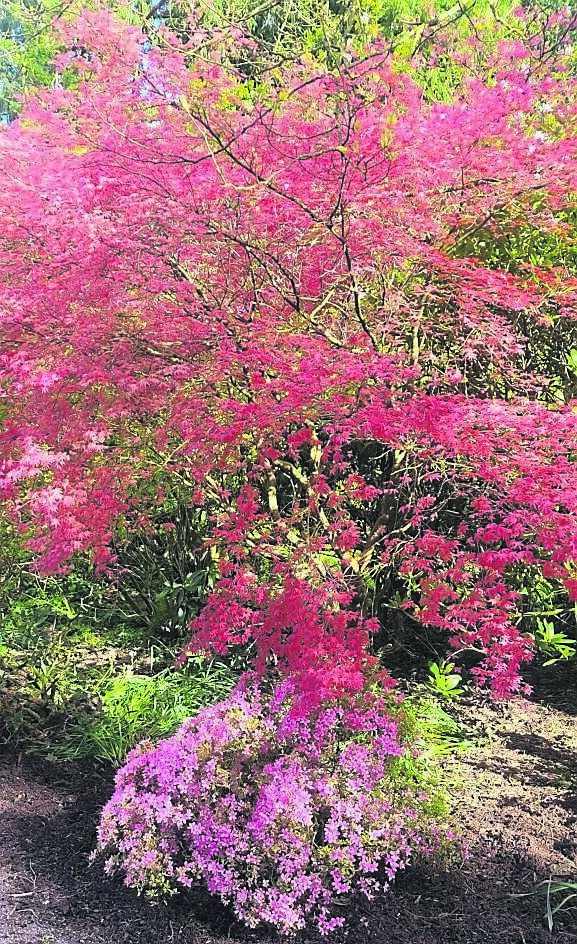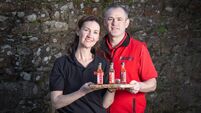In the Garden: Get creative to make lawn a wildlife haven

A checkerboard effect created in a grass area at Bellefield House, Co. Offaly, last year by head gardener Paul Smyth. Picture: Paul Smyth.
APRIL has just whizzed past and brought with it a change of fortunes weather wise thankfully.
It’s a busy month in the garden by normal standards, and this year even more so, with lots of jobs having to be delayed until the ground dried out somewhat.
Plenty of progress has been made this month and there is lots to look forward in the coming months.
It has been a cold April and not too much has been planted out of doors just yet, but seed sowing and germination is happening at a pace now.
The Clare Garden Festival is taking place this Sunday, April 28, at the showgrounds in Ennis and promises to be a great day with Jim Cronin, renowned for his organic growing techniques, as well as Kitty Scully, organic grower and TV presenter, Carl Wright of Caher Bridge garden in Clare, Michael Kelly of GIY, and Jo Newton, organic gardener, all giving talks and demonstrations throughout the day.
This year is the 10th anniversary of this garden festival which is one of the first of the year, and a great place to purchase edibles and ornamentals of all descriptions, as well as attending workshops and talks taking place on the day.
The leaves are bursting into life on deciduous trees and shrubs now, and the cycle begins once more as they generate energy from the sun in their leaves which fuels growth.
With plenty of moisture in the soil and the start of growth, it is a good time to consider feeding plants with chicken manure pellets, homemade compost or manure.
Established trees and shrubs will benefit from a boost to growth at this time of year and will look much healthier throughout the growing season as a result.
Weeding is an important undertaking now as the growing season kicks off, particularly around newly planted trees and shrubs.
When weeds become established, they can compete for water, nutrients and light, and newly- planted trees and shrubs will not have their roots established, which makes the first year after planting an important one to enable them to establish and become independent.

Buttercups, dockroots, dandelions, nettles and plantain are all perennial weeds that can smother new plants, and while they have a place in nature, we need to keep them under control in the garden or they can smother intentionally planted specimens.
Many of these weeds have a deep tap root and so a garden fork or spade will need to be employed to dig them out completely as hoeing or pulling will be a futile undertaking.
After digging out weed roots, applying a thick layer of mulch is a good investment which will serve a number of functions. It will be aesthetically pleasing, conserve moisture and smother weed seedlings if applied thickly enough.
Grass cutting has begun in earnest and lawnmowers and strimmers have been dusted down and serviced after a winter of rest in the shed.
‘No Mow May’ is approaching and provides a good opportunity to experiment with letting some of the lawn grow a bit longer, to let flowering plants such as dandelions, knapweed, yarrow, clover, ox eye daisy and Devils Bit Scabious, all commonly found growing amongst the grass in a lawn, flourish.
These will provide plenty of pollen and nectar for pollinators if they are allowed to flower.
May is an important month for pollinating insects, as they emerge after the winter and build up numbers once more.
May is also a time when there is a huge growth surge in the garden and flowering, particularly of herbaceous plants, really kicks off.
Keeping the lawn neat and tidy is a priority for many gardeners, and once the benefits of allowing some flowering of selective weeds is achieved, then perhaps priorities can change.
The outer edge of the lawn could be mown, for example, or a few paths through the lawn created in a playful manne, forming a pattern.
Some interesting patterns were cut in the grass at Bellefield House by Paul Smyth last summer, creating a checkerboard effect. There could be the potential for a lawn art project in the garden this summer!

Plant of the Week
As we are just about to enter peak cow parsley flowering time, with all the frothy umbels tumbling out from the ditches and roadside verges, there is an earlier umbel making an appearance in the herb garden.
It is Sweet cicely, or Myrrhis odorata.
This perennial clump-forming herb is part of the Apiaceae family and has anise scented delicate ferny foliage and edible white umbel flowers which will lure pollinators into the garden early in the year.
Not commonly encountered, it has the unique characteristic of adding sweetness to cooking so that less sugar is needed. It was traditionally cooked with rhubarb.
The leaves can be added to salads or chopped up and added to sauces. The young stems are particularly sweet as is the fresh new foliage.
Flowering early in the year, it will seed itself freely in the garden so it is a good idea to dead head it before it sets seed if this is not desirable.
It has a deep tap root which is also edible and so is best grown in the ground and not a pot.
A lovely addition to beds or borders, this will grow well in full sun or partial shade in a moist but well drained soil. It will get to about 90cm in height with a similar spread.







 App?
App?


